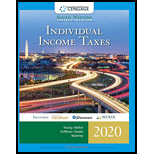
Compute net tax payable or refund due for T and S for 2019.
Explanation of Solution
Step 1: Compute taxable income of T and S for the year of 2019.
| Details | Amount ($) | Amount ($) | Reference |
| T’s net business | 124,000 | Refer working note 1 | |
| S’s salary | 145,000 | ||
| Interest income | 7,000 | ||
| Gross income | 276,000 | ||
| Less: Deduction for AGI | |||
| Capital losses | (3,000) | Refer working note 2 | |
| Self-employment tax deduction | (8,760) | (11,760) | Refer working note 3 |
| Adjusted gross income | 264,240 | ||
| Less: ‘From AGI deduction’ | |||
| Itemized deductions | (27,900) | ||
| Deduction for qualified business income | (23,048) | (50,948) | Refer working note 4 |
| Taxable income | $213,292 |
Step 2: Compute net tax payable or refund due for T and S.
| Details | Amount ($) | Amount ($) | Reference |
| Tax Liability | 39,539 | Refer working note 5 | |
| Add: Self-employment tax | 17,521 | Refer working note 3 | |
| Total tax liability | 57,060 | ||
| Less: Prepayments and credits: | |||
| Income tax withheld | (31,850) | ||
| Estimated tax payments | (20,000) | ||
| Child tax credit | 4,000 | Refer working note 7 | |
| Credit for child and dependent care expenses | (600) | (56,450) | Refer working note 6 |
| Net tax payable (refund due) | $610 |
Working note (1): Calculate T’s net business.
Working note (2): Calculate the capital losses for the year of 2019.
Step 1: Calculate short-term capital loss.
Step 2: Calculate long-term capital loss.
Step 3: Calculate total capital losses.
In a taxable year, an individual can deduct a maximum of $3,000 of net capital losses. Hence, T and S can deduct capital losses of $3,000.
Working note (3):
Calculate self-employment tax deduction.
Step 1: Calculate net earnings from self-employment.
Step 2: Calculate self-employment tax.
The self-employed tax rate for 2014 is 15.3% on the first $117,000 of net earnings from self-employment and then 2.9% on the portion in excess of $117,000.
Step 3: Calculate self-employment tax deduction.
In 2019, ‘For AGI Deduction’ the deduction part of the self-employment tax is 50% of self-employment tax. Hence, the deduction is $8,760.5
Working note (4): Calculate deduction for qualified business income.
Working note (5): Calculate tax liability for T and S.
Working note (6): Calculate credit for child and dependent care expenses.
In general, the maximum credit for child and dependent care expenses is limited to $3,000 for one qualifying child. The credit rate varies between 20% and 30%, depending on the AGI of the taxpayers.
In this case, the expenses are limited to 20% of $3,000 or $600. S is eligible to get the credit of $600 because, her age is under 13. But, D does not qualify to get the credit due to her age of 16.
The amount of credit for child and dependent care expenses is calculated as below:
Working note (7): Calculate child tax credit.
Both children are under age 17. Hence, both are qualifying for the child tax credit. So, the child tax credit is $4,000 (2 × $2,000).
Want to see more full solutions like this?
Chapter 13 Solutions
Individual Income Taxes
- Don't use ai. A company has the following data: Cash: $50,000Accounts Receivable: $30,000Inventory: $60,000Current Liabilities: $70,000a) What is the company’s acid-test ratio?b) Is the company in a strong liquidity position based on this ratio?arrow_forwardQuestion 5:A company has the following data: Cash: $50,000Accounts Receivable: $30,000Inventory: $60,000Current Liabilities: $70,000a) What is the company’s acid-test ratio?b) Is the company in a strong liquidity position based on this ratio?arrow_forwardQuestion 5: Acid-Test RatioA company has the following data: Cash: $50,000Accounts Receivable: $30,000Inventory: $60,000Current Liabilities: $70,000a) What is the company’s acid-test ratio?b) Is the company in a strong liquidity position based on this ratio?arrow_forward
- Question 4: Depreciation (Straight-Line Method)A company purchases machinery for $50,000. The estimated salvage value is $5,000, and the useful life is 10 years. a) Calculate the annual depreciation expense.b) What will the book value of the machinery be after 4 years?arrow_forwardInventory Valuation (FIFO Method)A company had the following inventory transactions during the month: Beginning inventory: 100 units @ $10 eachPurchase: 200 units @ $12 eachPurchase: 150 units @ $13 eachAt the end of the month, 250 units remain in inventory. Calculate the value of the ending inventory using the FIFO method. explainarrow_forwardNeed assistance without use of ai.arrow_forward
- Depreciation (Straight-Line Method)A company purchases machinery for $50,000. The estimated salvage value is $5,000, and the useful life is 10 years. a) Calculate the annual depreciation expense.b) What will the book value of the machinery be after 4 years?arrow_forwardA company has the following data: Cash: $50,000Accounts Receivable: $30,000Inventory: $60,000Current Liabilities: $70,000a) What is the company’s acid-test ratio?b) Is the company in a strong liquidity position based on this ratio?arrow_forwardDon't want AI answerarrow_forward
 Individual Income TaxesAccountingISBN:9780357109731Author:HoffmanPublisher:CENGAGE LEARNING - CONSIGNMENT
Individual Income TaxesAccountingISBN:9780357109731Author:HoffmanPublisher:CENGAGE LEARNING - CONSIGNMENT





